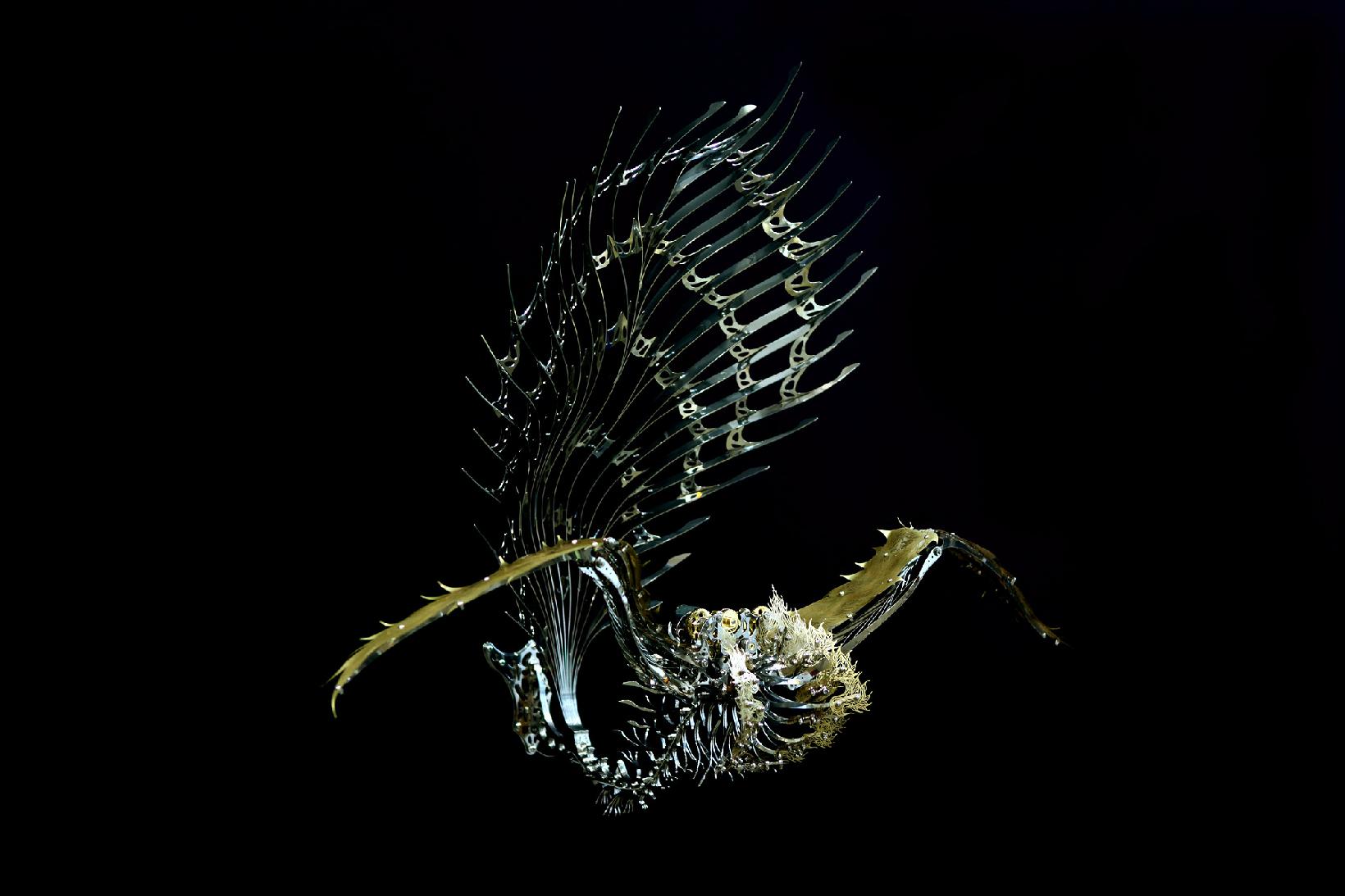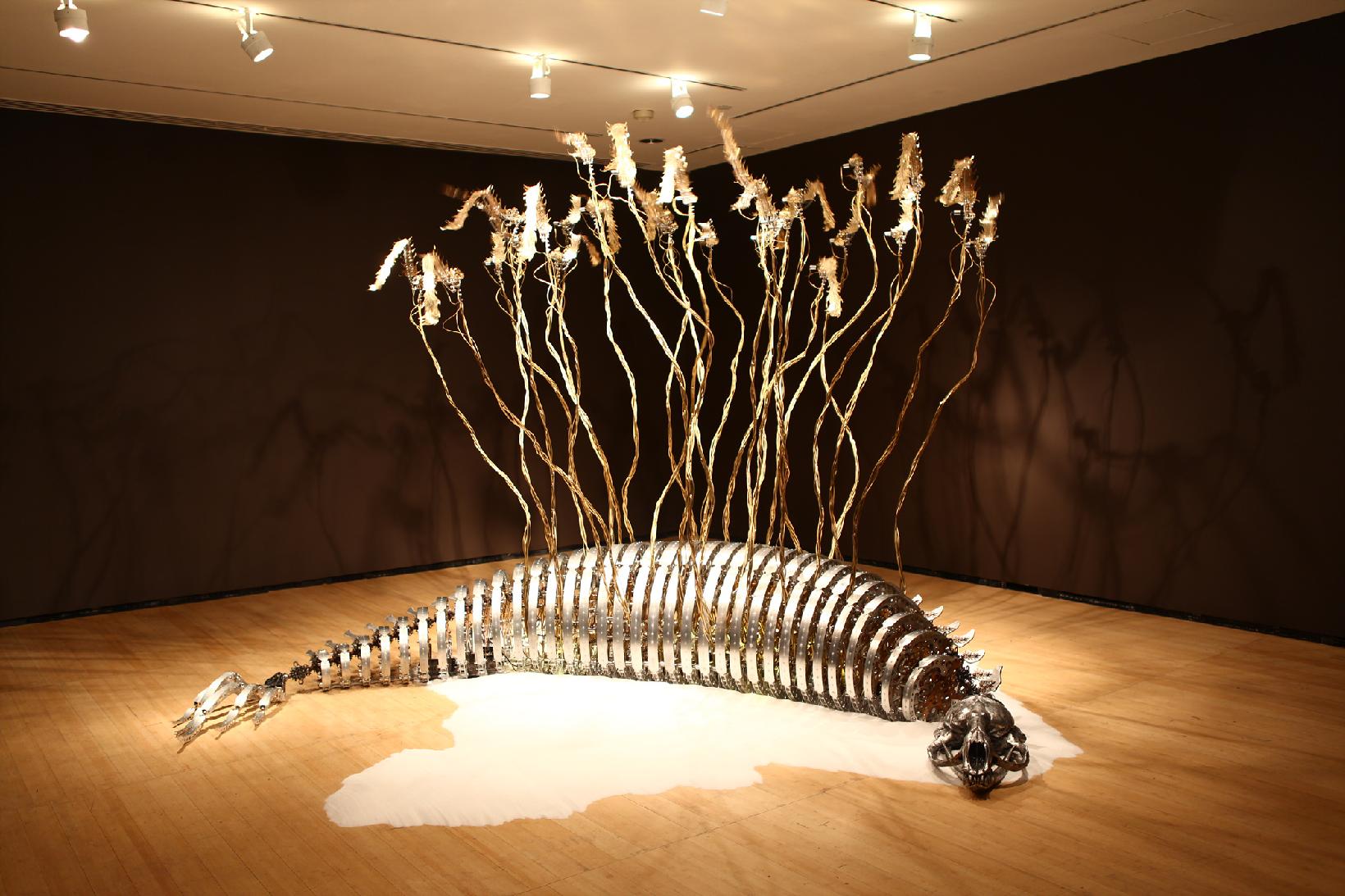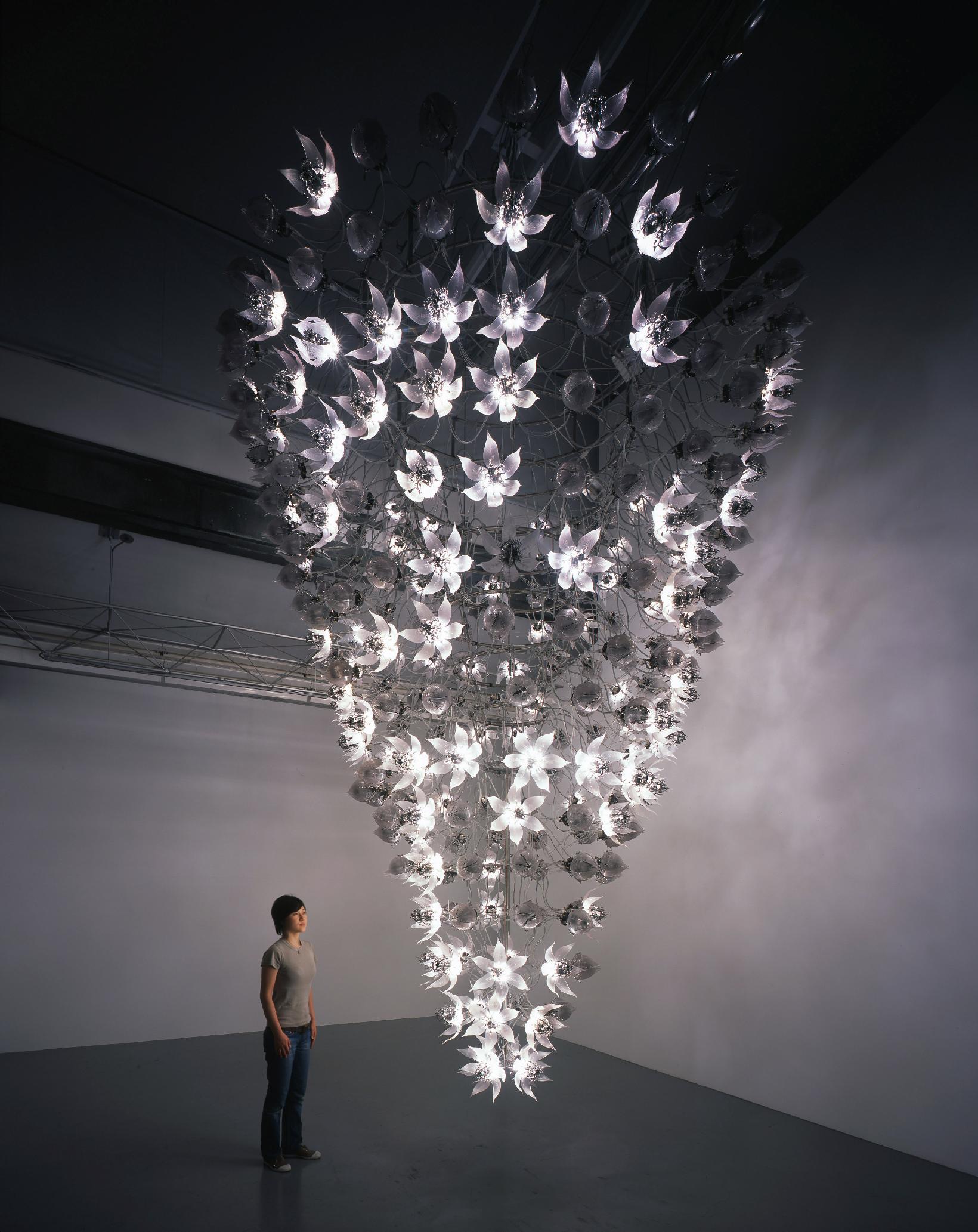
*글 하단의 '한국어 텍스트 다운로드'를 클릭하면 원문을 확인할 수 있습니다.
All of your work seems complicated and difficult to create in terms of work processes. This is the case for most of your work in the exhibition, but particularly the work, Custos Cavum (2011). Is the reason for such complicated process necessary to imitate organic forms as much as possible?
Yes, that’s true indeed. I use non-organic materials, but I try and want to make my work as organic as possible.
I am sure that it must be difficult because imitating organic forms with a machine is in fact impossible. Any organic being is comprised of multi-billion or trillion cells and it surely would be a challenging process to assembly each of these cells one by one. So let’s first talk about the work Custos Cavum.
My inspiration for Custos Cavum comes from ‘Weddell seals’, found in the Antarctica ice fields. I saw this on a nature documentary series on BBC. Weddell seals live in a very harsh environment at - 40 degrees and drill holes in the ice field; most of the times they tend to lie still, at rest, occasionally entering the water to hunt through the holes that they made. I noticed that these seals constantly drill holes on the ice field. I was also inspired by the frame of an airplane fuselage, because I found a similarity between these seals laying solely on the ice field and airplanes stranded on deserts. I love nature very much, and it is the source of my inspiration.

2011
Metallic material, resin, machinery, custom CPU board, LED
220 (h) x 360 (w) x 260 (d) cm
I get a feeling that you are very fond of both machines and nature; they are in a sense, manifestations of a very contrasting desire.
Yes, I have a great interest in nature, and it is the important source of ideas for my work. I wish I could visit all those great sites in person, but I gain a second-hand experience of nature through BBC documentaries. I re-play these documentaries over and over again, at least dozen times each. I once had the opportunity to road trip across the United States. At that time, I was greatly inspired by those places in which no human had contributed to shape their forms, such as the Grand Canyon. I also want to visit Africa, and do lots of traveling, if possible, in the future.
Not only Custos Cavum, but many of your other works also feature organic figures. I know movement in your work is very crucial, but if anyone is to take a look at your work via digitalized photo, they might miss this movement. Your work would be merely decorative because the feelings of the machine cannot be physically associated in person. This may create a dilemma; the issue coming from creating organic beings by inorganic materials. However, when I see them moving, your ideas are very convincing and acceptable. So, I think that it’s a bit daunting, and in some way, reckless to create something organic with inorganic materials. Or, taken another way, the urban city itself is in fact made up of machines, such as cars, subways, buildings, air conditioners and etc, you name it. These could never be portrayed or conveyed as organic, but the urban city overall seems like a huge, organic being, just like our hand is constituted of an almost inexhaustible numbers of cells. I think there’s a certain way in which these cells are organized. For some, we could say that they share a direct similarity with organic beings, or you could come up with entirely different figures. By the way, let’s talk about the engineering and programming part in your work. Do you map out engineering and programming for all the work by yourself?
I work with a programmer who majored in Electronic Engineering, and I’ve been working with him for the past 7 years. I think he has reached a level of mastery. In the beginning, I had to talk to him like this, ‘I want this turned 35 degrees clock wise at 25 RPM’, but now I only hint my feelings, such as, ‘Imagine yourself breathing with your hand on your chest!’ As for Custos Cavum, the programmer was solely responsible for directing the movement. When you breathe, the lung inhales very quickly and exhales in steady interval like a tube deflating air. In this motion, we put subtle difference between inflation and deflation so if one were to look at the figure, it really seems to be breathing in and out.

2012
Metallic material, motor, LED, CPU board, polycarbonate
850 (h) x 710 (w) x 670 (d) cm
Custos Cavum especially requires rather extensive observation than any other works. Most viewers, including me, would just pass by your work and maybe say, ‘Wow, what a complicated looking machine!’, and then just move on to the next piece. But for this work, one needs to take enough time to fully observe and savor it. Is this piece made of aluminium?
Yes. I have tried to resemble the feeling of an airplane shape for this work.
It is a very interesting attempt to actually produce a living organism while trying to assimilate the shape of an airplane using metallic machine. I could sense an interesting collision between the subtle feelings and hidden parts comprised in this work. Let’s talk about another work, Scarecrow (2012). Would you care to elaborate on it?
I have been mostly interested in things that are slightly detached from general daily life, such as nature, but then I saw the incident, ROKS Cheonan sinking in Korea in 2010, and wondered why people try to hide the truth and lie about the situation. Since then, I started to pay a little more attention to politics and power games. Actually, the power of information and internet-based information is too vast and diverse both in quantity and quality, and sometimes too viral. You can’t actually control the level and degree of information promulgation as much as the genuine reliability of information. We could say that information has now totally opened itself up to the public. If anyone has the will, there are many ways to find out what’s really going on. Before, people with power could manipulate the level of information provided to the public, but now the information, which is meant to be kept away from public attention, is available to everyone. Today everybody has access to all sorts of information. I do not necessarily want to judge this is good or bad, but I see this as moving toward a whole new arena of an information world with completely different perspectives. I wanted to create a visualized power of information in my work. For example, in the past, if anyone sought forgiveness or wanted to repent, they would go to a Buddhist temple or a church, praying for God’s mercy and seeking salvation, or wishing for a dream to come true. But today, many people express their feelings and wishes on SNS, tweeting their wishes and feelings, or they just talk about what happened that day, wishing and hoping that someone would respond to them by retweeting their statements. If someone tweets, ‘I’ve lost my puppy, what should I do?’, then followers try to help this person out, eventually finding the puppy after numerous retweets. Looking at this kind of phenomenon happening through the network, it reminds me of the sacrament of confession. If you think about it, it’s only information, lacking substance or physical mess, so I wanted to visualize the whole concept with an image. I produced a creature made of a complex network of wires, yet very hollow inside, and spreading its wings like an angel with glowing lights. You know, people say if you’re a sinner, you fear God when you are confronted with him, but if you’re a person with a good heart, you would like to be rewarded for your good deeds. I think this relationship exists in the network world. If you’re a person with power and privilege, you would fear the network out of anxiety that it might strip you off your vested interests, and may feel like the network will damage your reputation. However, if you’re on the good side and only want to utilize information for the common good, you are grateful for the existence of the network. I wanted to capture this dubious and twofold image of the network.
So, this angel is the embodiment of contradictions in many ways. This angel reminds me of Walter Benjamin’s note on ‘Angelus Novus’. Benjamin provided allegorical interpretations of Paul Klee’s Angelus Novus, which also depicts an angel spreading its wings like this work, Scarecrow. Benjamin interpreted that the angel is unable to furl its wings because of the enormous storm, coming from the future; and all it can do is to stare with resentment. There’s a pile of massive garbage in front of the angel and this is in fact our civilization. There’s nothing an angel could do in the situation. This angel could be a metaphor for human beings: we can only gape in front of this vast civilization, feeling powerless and helpless. I think the reality of information is similar to this. Also, while the original meaning of angel is ‘salvation’, this ‘angelus novus’ also connotes weakness because it cannot save or rescue us from the storm of ‘civilization’. It’s a bystander. Furthermore, as a machine critic myself, I want to see and discover certain suggestions or hints-or even a diagnosis of today’s machine civilization-from your works, like some sort of warning against today’s machine civilization?
I was mainly focused to those issues until quite recently; my first solo exhibition had a particular bent toward that notion. Some asks this question for joke, ‘what if the robots all go crazy?’ Then simply smiles and answers, ‘just turn off the switch!’. However, if a pilot is at the control of a falling airplane in real situation, the idea of ‘turning off the switch’ is very perilous to resolve the situation.
Could you tell me what your early works were like?
It was a very rough concept, even coarse, in a way. There was a work with some machine parts wiggling inside a test tube, another one titled, Mobius Syndrome I (1998) that presented machines moving like a spider with needles, and Watch Mania (1998-1999), a work that bloomed if anyone came near. I thought of this work while thinking of mass media’s violent witch hunts. Some works were bumping into each other since they move around wildly. At that time, I had this notion of an idea that the human position will be changed, and we are nothing but an intermediate host by which machines can evolve. In fact, the exhibition title was Civilization Host (1998).
2011
Metallic material, motor, gear, custom CPU board
82 (h) x 108 (w) x 45 (d) cm
Recently, I often talk about the post-humanity of machines at lectures or conferences. Machinery is something that humans created, but their functioning goes beyond the human perception. This is indeed true. The machine civilization is beyond human control in some ways. Also, all those thinkers about post-structuralism—Jacques Lacan, Michel Foucault, Jacques Derrida and many more—say that human subjectivity is a downward nothing. Lacan said human subjectivity is based on absence; Foucault said human subjectivity is essentially created by Panopticon. As for me, I was never such a big fan of humanity; I fundamentally have always been keener on machines and I do not think that all civilization is the product of human subjectivity. So you’re saying your works also convey these messages either?
Yes, indeed. In fact, I was thinking that machines are ahead of humans in many ways because they go places where humans cannot go and see things that we are not able to see. So I keep thinking what would happen if this phenomenon prolongs and continue, and if machines acquire life, everything will be totally different. All scientists and machine builders desire to overcome the handicap that life is created by God then dream to create it themselves. I think the animating lives into machines are the latent aspirations associated with God creating life.
Many people talk about artificial life, and I believe machines do already have life because the key to life is ‘self-reproduction’. For example, at an automobile factory, cars are mass-produced if the factory is properly functioning. Of course automobiles also have limited life span like humans, but these automobile series will continue on even if the CEOs of the company changes. Employees and the company system will continue to assemble series of cars. I think machines already have this kind of life force. For example, let’s assume you’re getting into a car or an elevator. Even though we start the car or press the floor button, we’re relying on the machine the very moment we get into them. We do not give a direction to the machine to go which exact miles at such and such speed, but they operate naturally. I think they already have a mechanical life, in that respect. In this notion, I often think that the definition of life is in the midst of a transformation.
People say that it is impossible to have absolute definition of life; that it is still a void concept.
As for that, if we look into the micro-organism level, viruses are not that different from the state of accumulated molecules. In other words, the boundary between living and nonliving organisms is not definite, thus the boundary between life and death is also obscure. I think it is the same for the machines. Though it is an artificial object by plastic and metal, it has been endowed life from you, as an artist. It seems to hold a moral message that we should value nonliving or inanimate organisms as well as living organisms.
This interview from the exhibition catalogue of Choe U-ram at Gallery Hyundai.